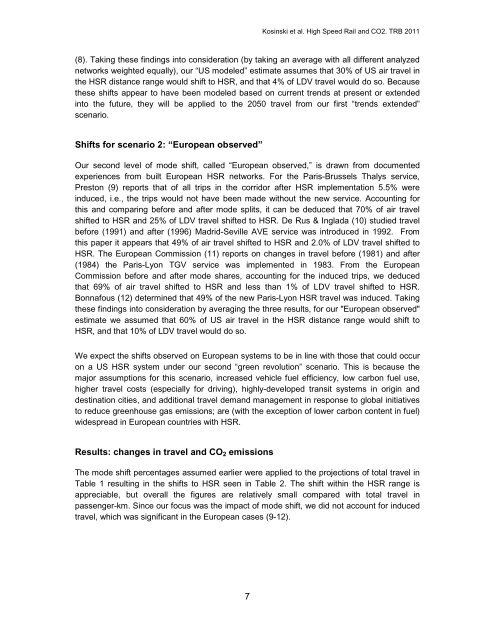Analysis of High-Speed Rail's Potential to Reduce CO2 Emissions ...
Analysis of High-Speed Rail's Potential to Reduce CO2 Emissions ...
Analysis of High-Speed Rail's Potential to Reduce CO2 Emissions ...
You also want an ePaper? Increase the reach of your titles
YUMPU automatically turns print PDFs into web optimized ePapers that Google loves.
7<br />
Kosinski et al. <strong>High</strong> <strong>Speed</strong> Rail and <strong>CO2</strong>. TRB 2011<br />
(8). Taking these findings in<strong>to</strong> consideration (by taking an average with all different analyzed<br />
networks weighted equally), our “US modeled” estimate assumes that 30% <strong>of</strong> US air travel in<br />
the HSR distance range would shift <strong>to</strong> HSR, and that 4% <strong>of</strong> LDV travel would do so. Because<br />
these shifts appear <strong>to</strong> have been modeled based on current trends at present or extended<br />
in<strong>to</strong> the future, they will be applied <strong>to</strong> the 2050 travel from our first “trends extended”<br />
scenario.<br />
Shifts for scenario 2: “European observed”<br />
Our second level <strong>of</strong> mode shift, called “European observed,” is drawn from documented<br />
experiences from built European HSR networks. For the Paris-Brussels Thalys service,<br />
Pres<strong>to</strong>n (9) reports that <strong>of</strong> all trips in the corridor after HSR implementation 5.5% were<br />
induced, i.e., the trips would not have been made without the new service. Accounting for<br />
this and comparing before and after mode splits, it can be deduced that 70% <strong>of</strong> air travel<br />
shifted <strong>to</strong> HSR and 25% <strong>of</strong> LDV travel shifted <strong>to</strong> HSR. De Rus & Inglada (10) studied travel<br />
before (1991) and after (1996) Madrid-Seville AVE service was introduced in 1992. From<br />
this paper it appears that 49% <strong>of</strong> air travel shifted <strong>to</strong> HSR and 2.0% <strong>of</strong> LDV travel shifted <strong>to</strong><br />
HSR. The European Commission (11) reports on changes in travel before (1981) and after<br />
(1984) the Paris-Lyon TGV service was implemented in 1983. From the European<br />
Commission before and after mode shares, accounting for the induced trips, we deduced<br />
that 69% <strong>of</strong> air travel shifted <strong>to</strong> HSR and less than 1% <strong>of</strong> LDV travel shifted <strong>to</strong> HSR.<br />
Bonnafous (12) determined that 49% <strong>of</strong> the new Paris-Lyon HSR travel was induced. Taking<br />
these findings in<strong>to</strong> consideration by averaging the three results, for our "European observed"<br />
estimate we assumed that 60% <strong>of</strong> US air travel in the HSR distance range would shift <strong>to</strong><br />
HSR, and that 10% <strong>of</strong> LDV travel would do so.<br />
We expect the shifts observed on European systems <strong>to</strong> be in line with those that could occur<br />
on a US HSR system under our second “green revolution” scenario. This is because the<br />
major assumptions for this scenario, increased vehicle fuel efficiency, low carbon fuel use,<br />
higher travel costs (especially for driving), highly-developed transit systems in origin and<br />
destination cities, and additional travel demand management in response <strong>to</strong> global initiatives<br />
<strong>to</strong> reduce greenhouse gas emissions; are (with the exception <strong>of</strong> lower carbon content in fuel)<br />
widespread in European countries with HSR.<br />
Results: changes in travel and <strong>CO2</strong> emissions<br />
The mode shift percentages assumed earlier were applied <strong>to</strong> the projections <strong>of</strong> <strong>to</strong>tal travel in<br />
Table 1 resulting in the shifts <strong>to</strong> HSR seen in Table 2. The shift within the HSR range is<br />
appreciable, but overall the figures are relatively small compared with <strong>to</strong>tal travel in<br />
passenger-km. Since our focus was the impact <strong>of</strong> mode shift, we did not account for induced<br />
travel, which was significant in the European cases (9-12).

















